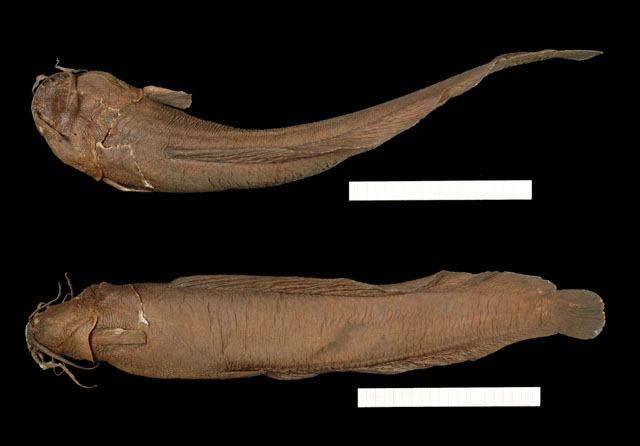|
Dorsal spines (total): 0-0; Dorsal soft rays (total): 72-83; Anal spines: 0-0; Anal soft rays: 58-65. Diagnosis: Tanganikallabes mortiauxi is distinguished from its congeners by the morphology of the vomerine toothpad, which, at its widest point anteroposteriorly, is thicker than the premaxillary toothpad, vs. a uniformly thin, broad crescent in other Tanganikallabes species; the presence of a complete lateral line, vs. incomplete lateral line; free lower orbital margin, vs. no free margin; well-defined, thick basal membranes on the barbels, vs. thin membranes; and a larger eye, 1.8-3.0% of standard length vs. 0.8-1.6% in Tanganikallabes alboperca or 1.0-1.9% in T. stewarti (Ref. 90118). The cranial osteology of T. mortiauxi further separates this species from all congeners: in T. mortiauxi, io-iv consists of a single element, vs. two separate elements in T. alboperca and T. stewarti; similarly, the suprapreopercle of T. mortiauxi is composed of a single element, whereas that of T. alboperca and T. stewarti is composed of two, or sometimes three, elements; furthermore, the extensions of the lateral ethmoid nearly overlie io-ii when viewed from above, but are well separated in T. alboperca and T. stewarti (Ref. 90118). Tanganikallabes mortiauxi can also be distinguished from T. alboperca by having longer pelvic fins, 7.4-9.3% of standard length vs. 6.0-7.7%, that reach beyond the origin of the anal fin when adpressed; longer pectoral fin spines, 5.6-8.8% of standard length vs. 3.6-5.3; a higher number of dorsal fin rays, 72-81 vs. 65-74; and the lack of a depigmented opercular margin (Ref. 90118). Tanganikallabes mortiauxi is further separated from T. stewarti by its proportionally longer prepelvic length, 39.7-44.4% of standard length vs. 35.7-39.2%; its proportionally longer preanal length, 47.1-51.7% of standard length vs. 42.4-44.8%; and shorter anal fin, anal fin base 47.6-54.2% of standard length vs. 54.1-58.9% (Ref. 90118).
Description: Body elongate, moderately compressed posterior to origin of dorsal fin; predorsal profile slightly convex, with small indentation formed by curvature and insertion of cheek muscles on skull; prepelvic profile convex; skin on body forming numerous vertical ridges and folds, extending onto and encasing all fins (Ref. 90118). Head depressed and broad; skin thick; lateral cranial muscles hypertrophied, forming trough in centre of head over bones of skull; snout short, with bluntly rounded margin when viewed dorsally; acute, narrow margin when viewed laterally; anterior nostrils tubular; posterior nostrils poorly visible, located at posterior base of nasal barbel; opercular flap extending over base of pectoral fin spine; eye small, located dorsolaterally; ovoid; horizontal axis longer; lower margin free; interorbital area broad, flat (Ref. 90118). Mouth terminal; lips narrow and papillate; jaws equal or upper jaw slightly longer; mandibular, premaxillary, and vomerine teeth pointed, unicupsid, arranged in multiple transverse rows; mandibular toothpad wide, crescentic; premaxillary toothpad broadly curved, rectangular; vomerine toothpad located immediately posterior to premaxillary; wider than premaxillary; broadly curved; crescentic (Ref. 90118). Nasal barbel extends approximately to upper origin of opercular flap; maxillary barbel extends nearly to end of pectoral fin; lateral mandibular barbel extending approximately to vertical through posterior tip of adpressed pectoral fin; medial mandibular barbel extending slightly beyond lower opercular margin; all barbels covered with thick, tuberculate skin, with broad basal membrane; membrane becoming increasingly crenulated in larger specimens (Ref. 90118). Dorsal fin elongate, lacking spine, with 72-83 soft rays; origin located approximately at vertical through posterior tip of adpressed pectoral fin; posterior margin not joined with caudal fin; pectoral fin I,7-9; strong spine, well-developed venom glands present; spine approximately 2/3 length of pectoral fin; posterior margin of spine with between zero and five very small, retrorse serrations; adipose fin absent; pelvic fin i,5; tip of adpressed fin reaches beyond origin of anal fin; anal fin elongate, with 58-65 branched rays; posterior margin not joined with caudal fin; caudal fin i,7,8,i; rounded (Ref. 90118).
Colouration: In alcohol, dorsum and flanks uniformly dark brown to black, with ventral surfaces slightly lighter; nasal, maxillary, and lateral mandibular barbels uniformly dark brown to black, sometimes with slightly lighter pigmentation near tips; medial mandibular barbels dark brown to black on proximal half, with distal half becoming noticeably lighter; all rayed fins uniformly dark brown to black (Ref. 90118). |

